It might astonish you to discover that harmful and dangerous fruits are present globally – consuming them can result in severe consequences such as vomiting, hallucinations, or possibly even death! So, the next time you’re about to eat something strange or unfamiliar, make certain it’s safe to ingest.
Here are 25 examples of potentially deadly fruits you might not know.
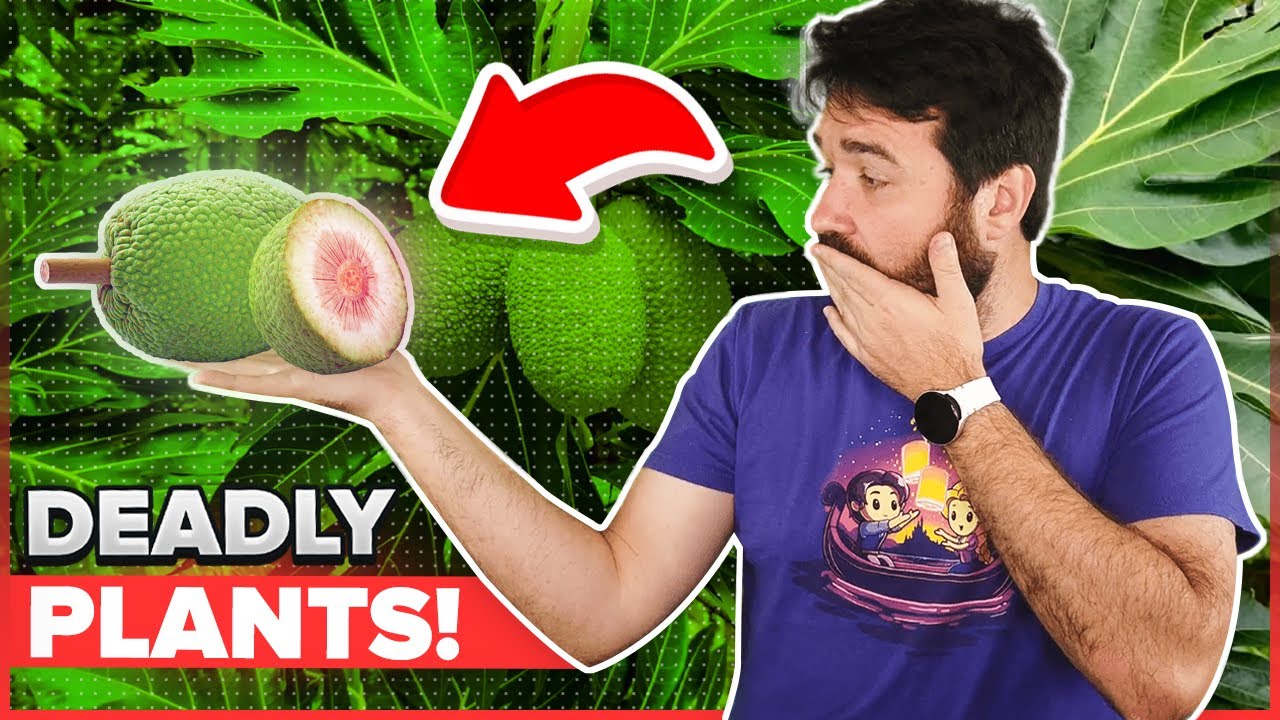
White Snakeroot (Eupatorium rugosum)
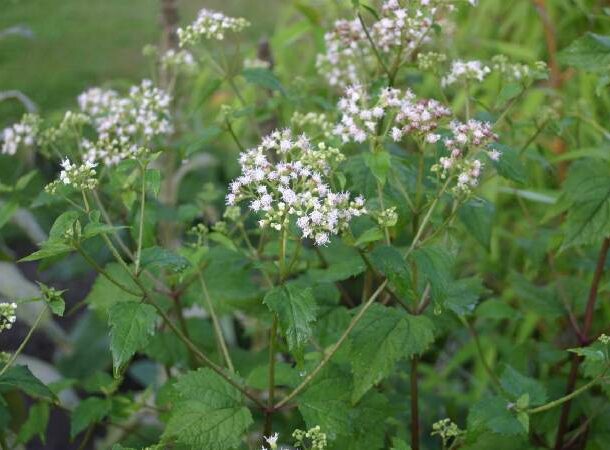
White snakeroot (Eupatorium rugosum) is a mysterious and potentially deadly plant that hails from the forests of the eastern United States. Despite its unassuming appearance, this plant packs a toxic punch – both its leaves and roots contain a dangerous substance known as tremetol. Consuming even a small amount of white snakeroot can lead to a condition called “milk sickness,” which is characterized by symptoms such as vomiting, tremors, and weakness. In severe cases, milk sickness can even be fatal.
But how did this plant get its ominous name? Some say that Native Americans used white snakeroot to treat snakebites, though this is a dangerous myth. White snakeroot is toxic to both humans and animals and should be avoided at all costs.
Water Hemlock (Cicuta spp.)
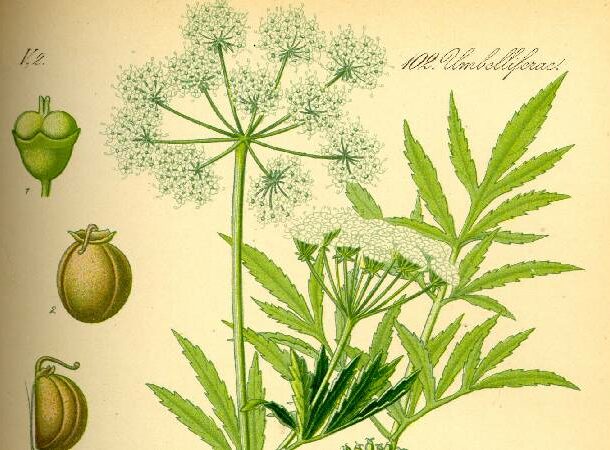
Water hemlock (Cicuta spp.) is a striking and potentially deadly plant that can be found in wet, marshy areas across North America and Europe. With its white, umbrella-shaped flowers and lacy green leaves, it’s no wonder that people are drawn to this plant. But beware – despite its charming appearance, water hemlock is one of the most poisonous plants in North America.
This plant gets its toxic reputation from the cicutoxins found in its roots and leaves. Consuming even a small amount of water hemlock can lead to symptoms such as vomiting, seizures, and death within just a few hours. Yikes!
But it’s not just humans that need to be on the lookout for water hemlock. This plant is also dangerous for livestock, who may mistake it for other, safe plants and consume it. If you suspect that you or someone you know (or even a furry friend) may have ingested water hemlock, it’s important to seek medical attention immediately.
Umbrella Tree (Schefflera spp.)
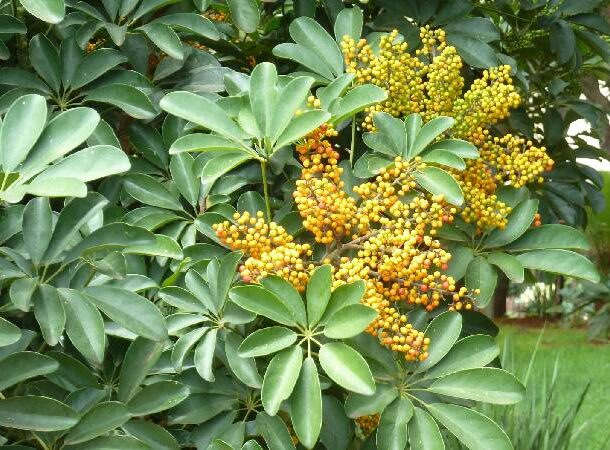
The umbrella tree (Schefflera spp.) is a tropical plant that is known for its distinctive, umbrella-shaped leaves and colorful, exotic flowers. Found in rainforests and tropical regions across the world, this plant is a popular choice for indoor and outdoor gardens. But beware – despite its beauty, the umbrella tree has a dark secret.
You see, the seeds of the umbrella tree contain toxins that can cause vomiting and diarrhea if ingested. And while it may be tempting to munch on these seeds (they do resemble small, shiny beads), it’s best to resist the temptation and keep your distance.
Tomato Leaves
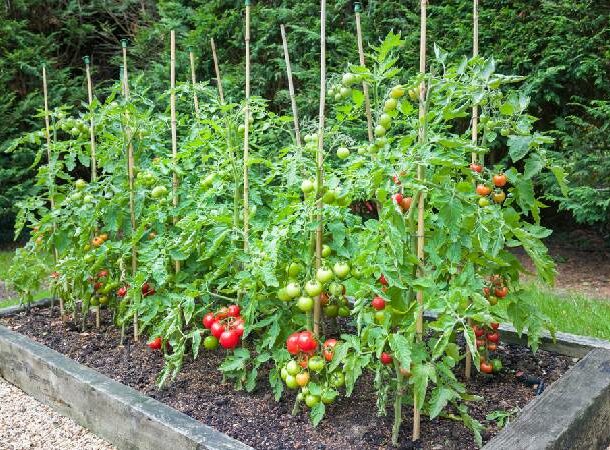
Tomatoes are a staple in many cuisines around the world, and their bright red fruit is a beloved ingredient in salads, sauces, and more. But did you know that the leaves of the tomato plant are poisonous?
That’s right – while the fruit of the tomato plant is perfectly safe to eat, the leaves contain toxins that can cause vomiting and diarrhea if ingested. So, while it may be tempting to use the leaves as a garnish or add them to your next salad, it’s best to avoid consuming them.
Tobacco plant (Nicotiana spp.)

The tobacco plant (Nicotiana spp.) is a striking and iconic plant that is known for its large, fragrant flowers and long, slender leaves. But this plant isn’t just famous for its good looks – it’s also the source of the addictive substance nicotine, which is found in cigarettes, tobacco products, and e-cigarettes.
While the nicotine in tobacco products can be highly addictive and harmful to your health, the leaves of the tobacco plant itself are also toxic. Ingesting the raw leaves can cause symptoms such as vomiting, dizziness, and death in large quantities.
Strychnine Tree (Strychnos spp.)
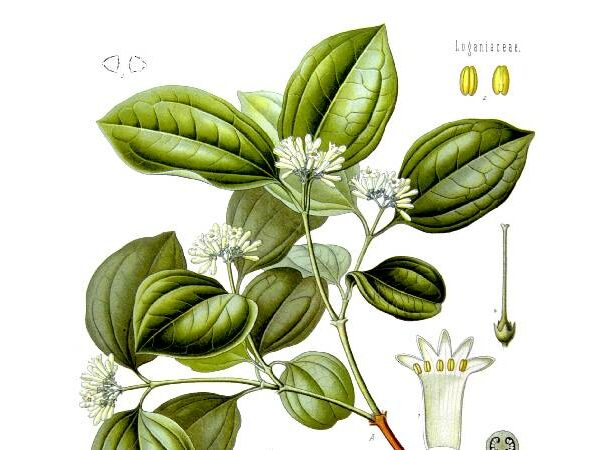
The strychnine tree (Strychnos spp.) is a mysterious and potentially deadly plant that is native to tropical regions of Africa, Asia, and South America. This plant is known for its shiny, black seeds, which contain a toxic compound called strychnine.
Strychnine is a potent poison that can cause symptoms such as vomiting, convulsions, and death if ingested. It has been used throughout history as a pesticide and as a means of killing pests and predators. However, it is also highly toxic to humans and animals and should be handled with caution.
Despite its deadly reputation, the strychnine tree is also known for its medicinal properties. In traditional medicine, the seeds of the plant have been used to treat a variety of ailments, including snakebites and respiratory problems. However, it is important to use caution when using any plant medicinally, as the wrong dosage or method of preparation can be dangerous.
Rosary Pea (Abrus precatorius)
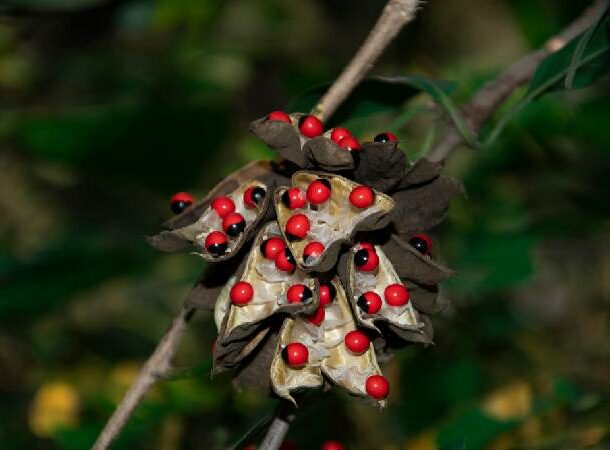
The rosary pea (Abrus precatorius) is a beautiful and exotic plant that is native to tropical regions of Asia and Africa. It is known for its long, slender vines and its bright red seeds, which are often used in jewelry and decorations.
But beware – despite their beauty, the seeds of the rosary pea contain toxins that can cause vomiting, diarrhea, and convulsions if ingested. The seeds are especially dangerous because they are small and easy to swallow, and they can be mistaken for other, safe seeds.
Oleander (Nerium oleander)
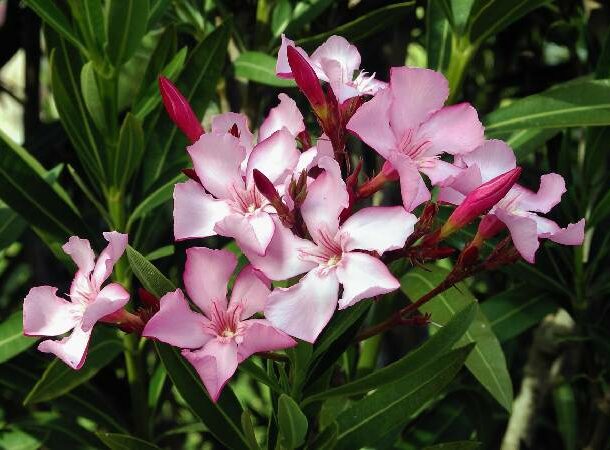
Oleander (Nerium oleander) is a stunning and exotic plant that is native to the Mediterranean region. It is known for its striking, pink, white, or red flowers and its glossy, green leaves. But beware – despite its beauty, oleander is a poisonous plant that can be harmful if ingested.
All parts of the oleander plant contain toxins that can cause symptoms such as vomiting, diarrhea, and heart problems if ingested. In large quantities, the toxins in oleander can be fatal.
Nutmeg (Myristica fragrans)

Nutmeg (Myristica fragrans) is a spice that is native to the tropical regions of Asia. It is known for its warm, sweet, and slightly pungent flavor, which is often used in baked goods, savory dishes, and drinks. But did you know that nutmeg can also be toxic in large quantities?
The active ingredient in nutmeg, called myristicin, can cause symptoms such as hallucinations, dizziness, and nausea if consumed in large amounts. While a small sprinkle of nutmeg in your pumpkin pie or eggnog is unlikely to cause any harm, consuming large amounts of nutmeg can be dangerous.
So, the next time you’re using nutmeg in your cooking, be sure to use it in moderation. A little bit of this warm and flavorful spice can go a long way, and it’s best to avoid consuming large quantities to stay safe.
Manchineel (Hippomane mancinella)
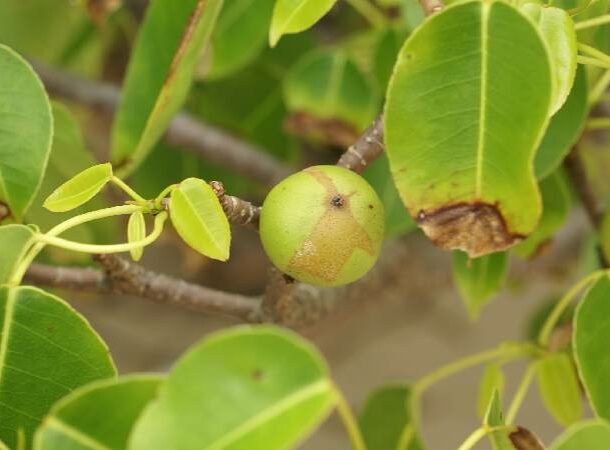
Manchineel (Hippomane mancinella) is a toxic and potentially deadly tree that is native to the tropical regions of the Americas. This tree is known for its small, green apples and its shiny, green leaves. But beware – despite its innocent appearance, manchineel is one of the most poisonous plants in the world.
All parts of the manchineel tree contain toxins that can cause symptoms such as blistering, vomiting, and diarrhea if ingested. The sap of the tree is also highly toxic and can cause severe skin irritation and blistering if it comes into contact with the skin. In severe cases, ingesting manchineel can be fatal.
Laburnum (Laburnum spp.)

Laburnum (Laburnum spp.) is a beautiful ornamental tree that is native to Europe. It is known for its bright yellow flowers and its long, slender seeds, which dangle from the branches like delicate necklaces. But beware – despite its charming appearance, laburnum is a poisonous plant that can be harmful if ingested.
All parts of the laburnum tree contain toxins that can cause symptoms such as vomiting, diarrhea, and tremors if ingested. The seeds are especially dangerous, as they can be easily mistaken for other, safe seeds. In severe cases, ingesting laburnum can be fatal.
Jatropha Curcas (Purge nut)
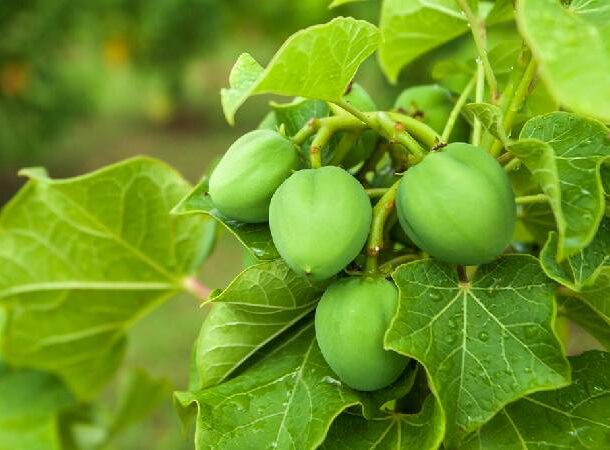
Jatropha curcas, also known as the purge nut, is a striking and exotic plant that is native to tropical regions of the Americas. It is known for its distinctive, red-orange seeds and its glossy, green leaves. But beware – despite its attractive appearance, jatropha curcas is a poisonous plant that can be harmful if ingested.
All parts of the jatropha curcas plant contain toxins that can cause symptoms such as vomiting, diarrhea, and tremors if ingested. The seeds are especially dangerous, as they can be easily mistaken for other, safe seeds. In severe cases, ingesting jatropha curcas can be fatal.
Hogplum (Spondias mombin)
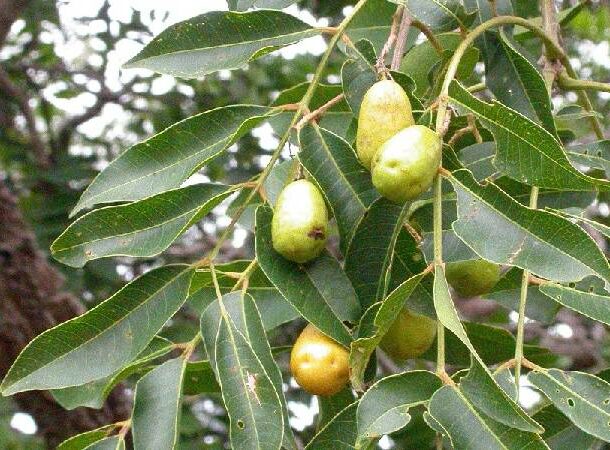
Hogplum (Spondias mombin) is a tropical fruit tree that is native to the Americas. It is known for its bright yellow or orange fruit and its glossy, green leaves. However, despite its attractive appearance, hogplum is a poisonous plant that can be harmful if ingested.
The seeds and unripe fruit of the hogplum tree contain toxins that can cause symptoms such as vomiting, diarrhea, and tremors if ingested. In severe cases, consuming hogplum can be fatal.
Ginkgo nuts

Ginkgo nuts are the seeds of the ginkgo tree (Ginkgo biloba), a tree that is native to China and is known for its distinctive, fan-shaped leaves and its ability to survive in harsh environments. Ginkgo nuts have a creamy, nutty flavor and are often used in cooking, especially in Chinese and Japanese cuisine.
But beware – despite their delicious flavor, ginkgo nuts can be toxic if consumed in large quantities. The seeds contain toxins that can cause symptoms such as vomiting, diarrhea, and tremors if ingested. In severe cases, consuming ginkgo nuts can be fatal.
Four O'clock Plant (Mirabilis spp.)
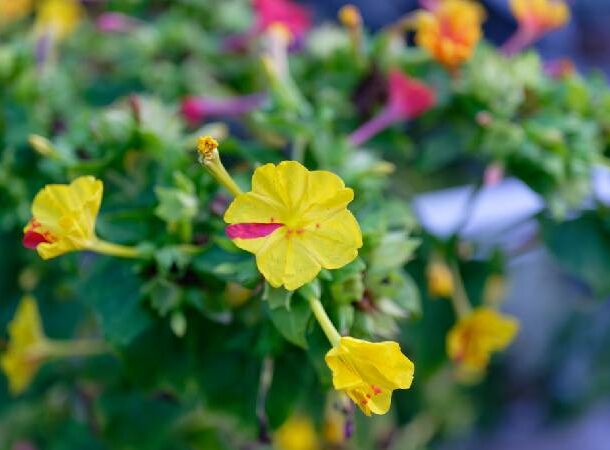
The four o’clock plant (Mirabilis spp.) is a colorful and exotic plant that is native to tropical and subtropical regions of the Americas. It is known for its bright and fragrant flowers, which bloom in the late afternoon and evening, hence its name. The four o’clock plant might look charming, but is actually a poisonous plant that can be harmful if ingested.
All parts of the four o’clock plant contain toxins that can cause symptoms such as vomiting, diarrhea, and tremors if ingested. The seeds are especially dangerous, as they can be easily mistaken for other, safe seeds. In severe cases, ingesting four o’clock can be fatal.
Elderberries (Sambucus spp.)
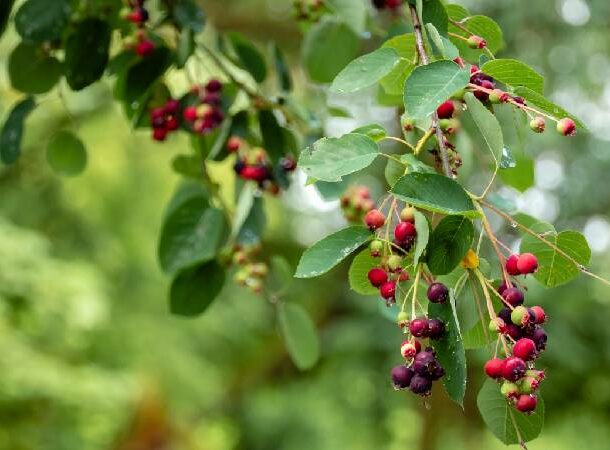
Elderberries (Sambucus spp.) are a type of berry that is native to the temperate regions of the Northern Hemisphere. They are known for their dark, purplish-black color and their sweet and slightly tart flavor, which is often used in pies, jams, and syrups.
But beware – while elderberries are safe to eat when cooked, the raw berries and other parts of the elderberry plant, such as the leaves and stems, contain toxins that can cause symptoms such as nausea, vomiting, and diarrhea if ingested. In rare cases, consuming raw elderberries can also cause a severe allergic reaction.
Chinese Lantern Plant (Physalis alkekengi)

The Chinese lantern plant (Physalis alkekengi) is a colorful and exotic plant that is native to Asia and Europe. It is known for its bright orange, papery lanterns that enclose the fruit and its delicate, white flowers. Despite its attractive appearance, the Chinese lantern plant is a poisonous plant that can be harmful if ingested.
All parts of the Chinese lantern plant contain toxins that can cause symptoms such as vomiting, diarrhea, and tremors if ingested. The seeds are especially dangerous, as they can be easily mistaken for other, safe seeds. In severe cases, ingesting Chinese lantern can be fatal.
Chaya (Cnidoscolus chayamansa)
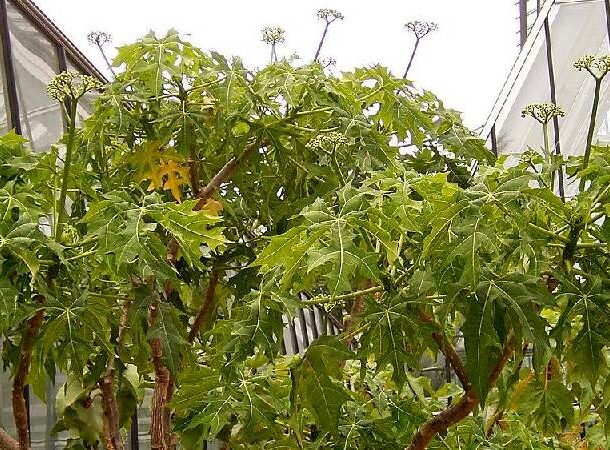
Chaya (Cnidoscolus chayamansa) is a tropical plant that is native to Central and South America. It is known for its large, glossy leaves and its thick, woody stem, which is often used as a natural remedy for a variety of ailments. However, chaya is a poisonous plant that can be harmful if ingested.
All parts of the chaya plant contain toxins that can cause symptoms such as vomiting, diarrhea, and tremors if ingested. The toxins in chaya are especially dangerous because they are not destroyed by cooking or boiling, and must be carefully removed before the plant is safe to eat.
Cerbera Odollam (Suicide tree)
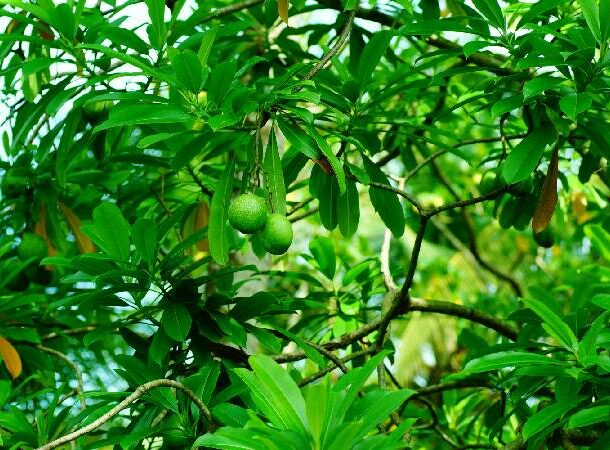
Cerbera odollam, also known as the suicide tree, is a tropical plant that is native to India and Southeast Asia. It is known for its small, yellowish fruit and its large, glossy leaves. But beware because, despite its innocent appearance, cerbera odollam is a poisonous plant.
All parts of the cerbera odollam plant contain toxins that can cause symptoms such as vomiting, diarrhea, and tremors if ingested. In large quantities, the toxins in cerbera odollam can be fatal.
Cashew Nut Shells

Cashew nut shells are the outer covering of the cashew nut, a nut that is native to Brazil and is known for its distinctive, kidney-shaped form and its sweet and slightly crunchy texture. Cashew nut shells are often discarded or used as fuel, as they contain an oil that can irritate the skin and respiratory tract.
But did you know that cashew nut shells are poisonous if ingested? The oil that is found in the shells contains toxins that can cause symptoms such as vomiting, diarrhea, and tremors if ingested. In severe cases, consuming cashew nut shells can be fatal.
Apple Seeds
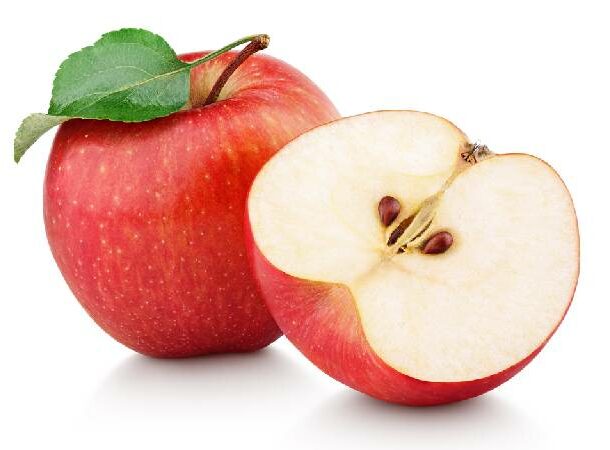
Apple seeds are the small, hard seeds that are found inside apples, a fruit that is native to Central Asia and is known for its juicy, sweet flavor and its crisp, crunchy texture. Apple seeds are often discarded or spit out when eating an apple, as they have a bitter taste and are not very palatable.
But did you know that apple seeds are poisonous if ingested in large quantities? Apple seeds contain a small amount of a toxic compound called amygdalin, which can release cyanide when it comes into contact with digestive enzymes. In large quantities, cyanide can be fatal.
Akee (Blighia sapida)
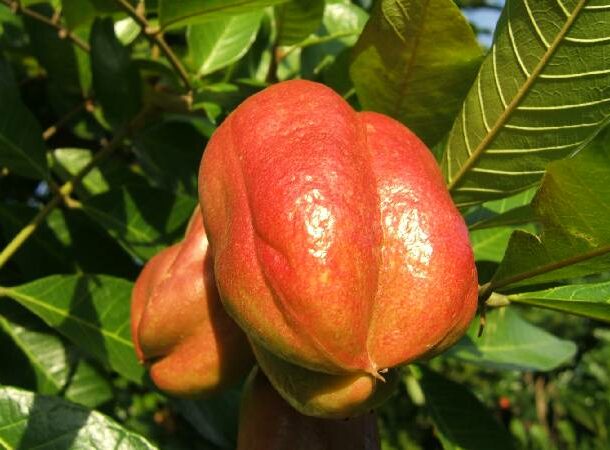
Akee (Blighia sapida) is a tropical fruit that is native to West Africa and is known for its distinctive, pear-shaped form and its soft, creamy flesh. Akee has a slightly nutty flavor and is often used in cooking, especially in West African and Caribbean cuisine.
But beware – while akee is safe to eat when it is fully ripe and cooked, the unripe fruit and seeds of the akee plant contain toxins that can cause symptoms such as vomiting, diarrhea, and tremors if ingested. In severe cases, consuming unripe akee can be fatal.
African Breadfruit (Treculia Africana)
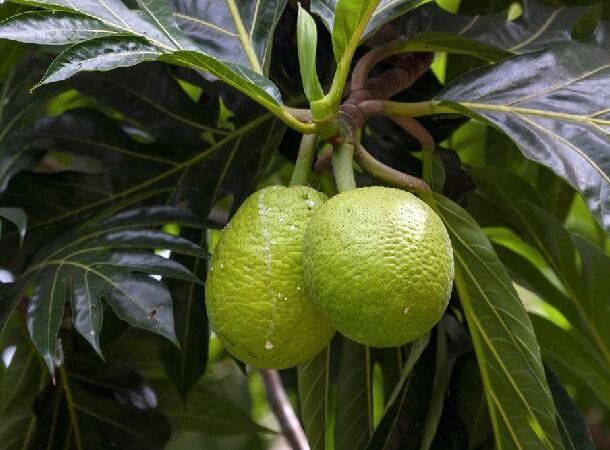
African breadfruit (Treculia Africana) is a tropical fruit that is native to West and Central Africa and is known for its large, spherical form and its soft, starchy flesh. African breadfruit has a slightly sweet and nutty flavor and is often used in cooking, especially in West and Central African cuisine.
While African breadfruit is safe to eat when it is fully ripe and cooked, the unripe fruit and seeds of the African breadfruit tree contain toxins that can cause symptoms such as vomiting, diarrhea, and tremors if ingested. In severe cases, consuming unripe African breadfruit can be fatal.
Gympie-gympie (Dendrocnide spp.)
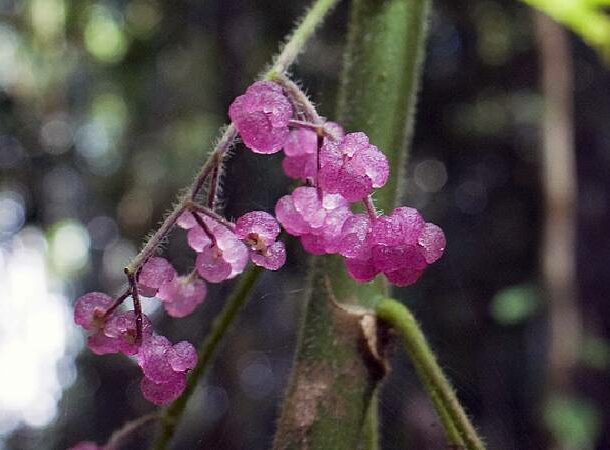
Gympie-gympie (Dendrocnide spp.) is a tropical plant that is native to Australia and is known for its large, glossy leaves and its small, inconspicuous flowers. Gympie-gympie might look unassuming but is a poisonous plant that can be harmful if touched.
The leaves and stem of the gympie-gympie plant contain toxins that can cause severe pain and skin irritation if touched. In severe cases, contact with gympie-gympie can be fatal.
Durian (Durio spp.)
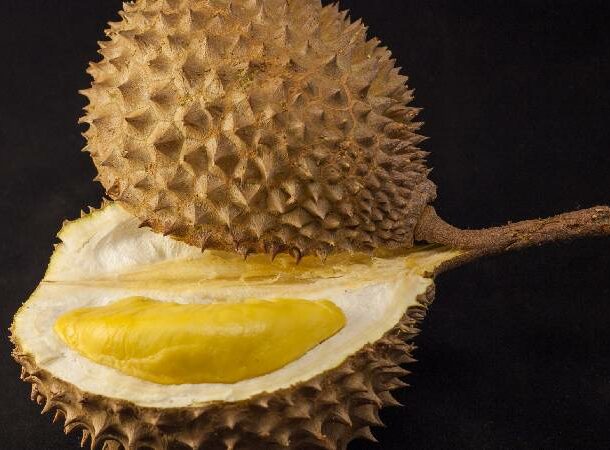
Durian (Durio spp.) is a tropical fruit that is native to Southeast Asia and is known for its distinctive, spiky exterior and its rich, creamy flesh. Durian has a strong and pungent aroma that some people find off-putting, but many others find it irresistible and describe it as a mix of sweet and savory flavors.
Durian is safe to eat when it is fully ripe, but the unripe fruit and seeds of the durian tree contain toxins that can cause symptoms such as vomiting, diarrhea, and tremors if ingested. In severe cases, consuming unripe durian can be fatal.



























